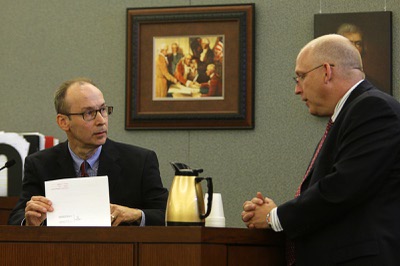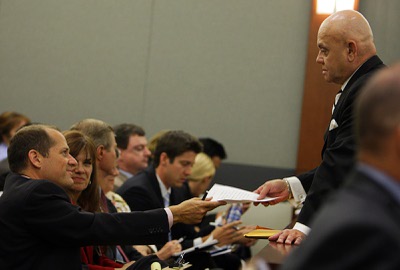
Dr. Alane Olson, a medical examiner for the coroner’s office, testifies about morphine levels in Erik Scott’s blood during a coroner’s inquest at the Regional Justice Center Wednesday, September 22, 2010.
Wednesday, Sept. 22, 2010 | 9:48 p.m.
Sun Archives
- Family critical of process as inquest into police shooting set to start (9-16-2010)
- Attorney for family in police shooting calls inquest process ‘a farce’ (9-16-2010)
- Attorney in Erik Scott case sends letter to judge over evidence (9-16-2010)
- Erik Scott’s family asks to view evidence before inquest (9-9-2010)
- Inquest into police shooting to be broadcast on cable TV (9-7-2010)
- Inquest set for Sept. 22 in police Costco shooting (8-12-2010)
- Metro mails Costco customers to find witnesses in police shooting (8-18-2010)
- Candlelight vigil held in memory of man killed by Metro Police (8-11-2010)
- Planning for a situation like recent Costco shooting not easy for police (7-19-2010)
- Man killed by police in Costco shooting honored at memorial (7-17-2010)
- Metro IDs officers in fatal shooting at Summerlin Costco (7-12-2010)
- Officers fatally shoot armed man at Summerlin Costco (7-10-10)
Colleen Kullberg was among the last to leave the Summerlin Costco store on July 10. The store was being evacuated — it could be a bomb threat, she thought — but as she was leaving the store, she wasn’t sure why she had been ordered out.
But after Kullberg, a part-time customer service employee, made her way from the back of the store where she was stationed to the front exit, it wasn’t a bomb that confronted her. A very different sort of explosive scene unfolded in front of her eyes, she testified on Wednesday.
A man, later determined to be Erik Scott, was staring at a Metro Police officer. Scott was standing with his arms to his sides and appeared to be dazed, she said.
He then reached around behind him and, with his right hand, removed a gun from his waistband and brought it forward, pointing it at the officer.
“What did you think he was going to do?” asked Chief Deputy District Attorney Christopher Laurent.
“Shoot,” she said.
But before that could happen, the officer fired.
Kullberg was the final witness called during the first day of testimony in the coroner’s inquest into Scott’s death. The 38-year-old medical device salesman, a graduate of West Point and Duke University, was shot to death outside the Summerlin store on a busy Saturday afternoon.
Police responded to the store after a security employee called 911 to report a man was acting erratically, destroying merchandise. The caller told dispatchers the man had a gun and was possibly high on drugs.
Kullberg said that before shots were fired, the officer said “at least five times” for Scott to “get on the ground.”
“He was like, dazed,” she said. “He was not obeying any of (the officer’s) commands.”
On Wednesday, Laurent and Assistant District Attorney Chris Owens presented evidence that Scott had an addiction to hydrocodone, a prescription narcotic painkiller.
Dr. Alane Olson, a medical examiner in the Clark County Coroner’s Office, testified that Scott had a number of drugs in his system when he died. The levels of morphine and xanax found by a toxicology screen conducted after his death were very high and potentially lethal, she said.
The levels also indicated that he had likely built up a tolerance to the drugs over time, she said.
He died from multiple gunshot wounds, she said, and the death was ruled a homicide.
Seven bullets struck Scott’s body — five in the back, two in the front — but she couldn’t determine in which order the rounds struck him or from how far away they were fired, she said.
Dr. Shari Klein, a family practice doctor who has been practicing in Las Vegas for about 10 years, was the first of Scott’s physicians to testify. Klein treated Erik Scott for two years, until August 2009. She said he stopped coming to her for treatment because of financial hardship.
She told the jury that during that time he tried to get her to prescribe hydrocodone, which he told her he wanted for depression.
She said he told her he had chronic elbow and knee pain but never mentioned any back pain.
Later in the day, other doctors would testify that Scott told them he had suffered from chronic back pain for more than 15 years as a result of injuries sustained while he was a cadet at West Point coupled with a football injury.
Klein runs what she described as a “concierge” clinic, meaning she keeps the number of patients she sees small so that they have better access to her.
One of the ways that her patients can access her is via e-mail. Some of her e-mail correspondence with Scott was presented to the jury. In those e-mails, Scott told Klein that he had a high tolerance for medication. He said he wanted hydrocodone as a treatment for his depression.
In August 2009, he sent an e-mail saying he was suffering from chronic lower back pain and suggested the doctor could use that as a reason to give him the prescription, if she was uncomfortable prescribing it for depression.
Klein testified she never prescribed that medication for him. She said she never prescribed him morphine or any other narcotic. In response to his e-mails, Klein tried to get him to come in for a consultation, but he decided to drop her as his doctor in August 2009 for financial reasons, she said.
Dr. Daniel Kim, whose specialty is pain management, said he began treating Scott on Feb. 2, 2010, for chronic abdominal pain.
Kim said he prescribed medication for Scott that should have taken care of his pain. But about two weeks later, Scott contacted Kim to say he was out of medication. The medicine was supposed to last four weeks, until Scott’s next appointment.
“He doubled up everything that I gave to him,” Kim said.
Kim said he terminated Scott from his clinic and referred him to a list of detoxification centers.
“My conclusion is that he is suffering from an addiction, at the least to hydrocodone, if not to other narcotic substances,” Kim said.
Kim said it was possible for people to be addicted to a narcotic substance and still do their jobs. He said about 5 to 10 percent of people who come to pain clinics might be addicted to their pain medications.
Scott told Kim he had been treating his back pain with common over-the-counter drugs for years but the pain had become unbearable.
Kim said another doctor, a gastroenterologist, had already given Scott a prescription for hydrocodone before he began treating him.
Kim said that after reviewing test results and other medical reports, he couldn’t find any pathology that would explain Scott’s abdominal pain. He attributed it to being a possible symptom of withdrawal from hydrocodone.
The jury also heard about 40 minutes of testimony from Dr. Joseph Gnoyski, who treated Scott for lower back pain with prescription narcotics, which included morphine and hydrocodone starting in February 2010.
He said Scott told him he had suffered back pain for 17 years from a paratrooping accident and from an earlier football injury. But Gnoyski said Scott told him the pain had grown much worse in February, following an automobile accident.
Gnoyski said Scott described his pain as a “10 out of 10” after the auto accident and said he couldn’t function. He said Scott described the pain as if someone hit him with a baseball bat.
Gnoyski said he ordered an MRI for Scott and found Scott had a broken back, an unstable spine and a ruptured disk. Gnoyski said that after discussing various treatment options, Scott didn’t want surgery because it wasn’t guaranteed to be successful and had a number of risks, including the possibility for an increase in pain.
Gnoyski said he saw Scott seven times. Initially, he didn’t follow the treatment, Gnoyski said, but midway through the treatment, Scott began complying with his doctor’s orders.
Gnoyski said Scott’s final visit with him was an informal visit in a hallway on July 1. Scott seemed to be groggy and had stumbled a couple of times, the doctor said.
“After 40 to 50 paces, he regained his composure. I had thought he might not have used his meds appropriately,” Gnoyski said. “My last dealing was to try to get him into my office.”
Gnoyski testified he didn’t think Scott was a drug seeker.
“This guy works out every day. It’s not like he is seeking a buzz just to lie around,” Gnoyski said. “... I don’t believe this man was trying to get a buzz ... It just doesn’t mesh with his character.”
He said Scott was a high-level athletic performer, similar to an acrobat who might be in a Cirque du Soleil show on the Las Vegas Strip.
“I have a lot of respect for him,” Gnoyski said.
Gnoyski said there is a difference between someone who is an addict and someone who seems to be an addict who needs drugs for pain. But someone who seems to be an addict will begin to cut back on their medication once they begin to manage that pain.
Gnoyski said when he saw Scott act in a groggy manner, “it wasn’t like he was out of control, that he was going crazy.” He said he seemed to be functional.
Laurent pointedly asked if Gnoyski knew if Scott was getting additional narcotics from any other source. The doctor said he didn’t know.
A report had been filed with a state task force that indicated Scott had received multiple prescriptions for narcotics from different doctors, which Laurent pointed out is a felony in Nevada.
Gnoyski said Scott had a physiological dependency to the narcotics he was taking, but that wasn’t the same as an addiction, which also includes a psychological dependency, he said.
About 2 to 5 percent of people who take such medications become addicted, he said.
Gnoyski said that over a period of time, Scott began to get better and that his pain level diminished from a “10 out of 10” to a “two out of 10” on a pain scale.
Laurent asked him if the dosage of morphine that Scott had been taking could have caused him to misunderstand directions. Gnoyski said Scott should have been able to follow directions.
Laurent also showed the jury a letter Gnoyski had drafted to cut Scott off as a patient following the informal July 1 encounter.
Gnoyski said he changed his mind and didn’t send the letter. He decided to have Scott come back into the office for treatment and reduce the amount of hydrocone he was taking and, eventually, the amount of morphine.
A jury of 11, which includes four alternates, is hearing testimony at the inquest. The proceedings are slated to run through the end of this week and possibly spill into next week.
The ACLU and Scott’s family have criticized the inquest process, calling it one-sided. Inquests are not adversarial in nature; rather, they are fact-finding procedures designed to determine the facts surrounding police officer-involved deaths.
Metro has identified the three officers involved as William Mosher, 38, who has been with the department since June 2005; Joshua Stark, 28, with the department since September 2008; and Thomas Mendiola, 23, with the department since March 2009.
The men have been on paid administrative leave since the shooting, in accordance with department policy. All three are patrol officers assigned to the Northwest Area Command.
In addition to the three officers, also expected to testify are dozens of witnesses — both shoppers and employees — who were at Costco at the time of the shooting. Scott’s girlfriend, Samantha Sterner, who was with him at the shopper’s warehouse club store, is also scheduled to take the stand.
Following the day-long inquest, Scott’s family members met briefly with their attorney, Ross Goodman. They then went outside, where Goodman talked to reporters on the east sidewalk outside the Regional Justice Center in downtown Las Vegas.
Goodman told reporters that prosecutors for the Clark County District Attorney’s Office were trying to “character assassinate” Scott.
“Erik Scott worked 60 hours a week. He was interacting with his girlfriend. He was a upstanding guy. And whatever medication that Erik was taking had no effect on him whatsoever,” Goodman said.
Asked why prosecutors were dwelling on the medication, Goodman said it was because there was no video showing that the officers shot Scott “in cold blood.”
He also dismissed as “questionable” the dramatic final testimony that jurors heard Wednesday from Kullberg.
“All I know is that in interviewing at least 20 to 25 witnesses, Erik didn’t pull a gun or point a gun at anybody,” Goodman said.
Jurors will determine whether the shooting was justifiable, excusable or criminal. Coroner’s juries do not have to be unanimous in reaching their verdict.
Proceedings are schedule to resume at 9 a.m. Thursday.







Join the Discussion:
Check this out for a full explanation of our conversion to the LiveFyre commenting system and instructions on how to sign up for an account.
Full comments policy